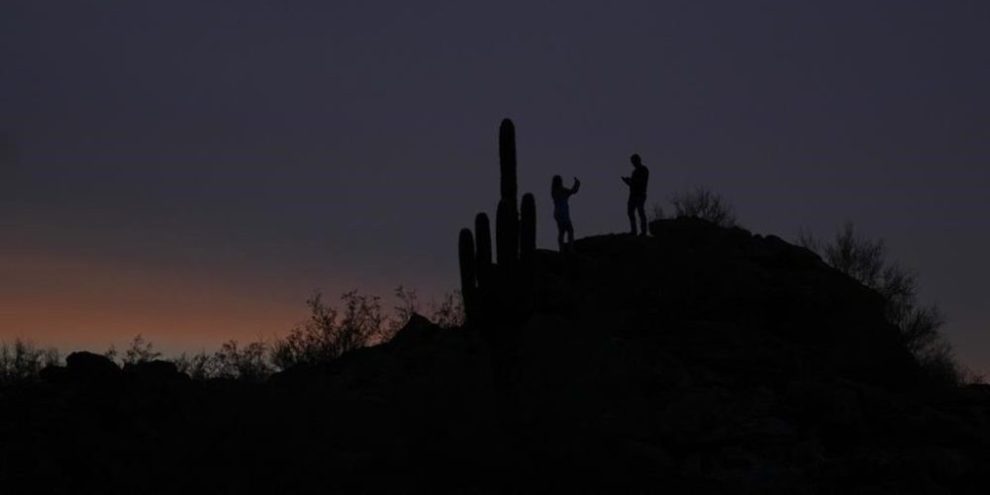
Anita Snow And Drew Costley, The Associated Press
A record string of daily highs over 110 degrees Fahrenheit (43.3 degrees Celsius) in Phoenix ended Monday as the dangerous heat wave that suffocated the Southwest throughout July receded slightly with cooling monsoon rains.
The historic heat began blasting the region in June, stretching from Texas across New Mexico and Arizona and into California’s desert. Phoenix and its suburbs sweltered more and longer than most, with several records including 31 consecutive days of 110 degrees Fahrenheit−plus (43.4 degrees Celsius) weather. The previous record was 18 straight days, set in 1974.
The streak was finally broken Monday when the high topped out at 108 degrees Fahrenheit (42.2 Celsius) at 3:10 p.m.
“The high temperature for Phoenix today is 108 degrees,” Jessica Leffel, meteorologist for the National Weather Service, said at 5 p.m.
“The record streak of 31 straight days of 110+ degree temperatures has ended.,” the weather service said on social media. “The high temperature at Phoenix Sky Harbor Airport reached 108 degrees this afternoon, which is only 2 degrees above normal.”
The reprieve was expected to be brief, with the forecast calling for highs again above 110 for several days later in the week. And National Weather Service meteorologist Matthew Hirsch said August could be even hotter than July.
But residents and visitors were taking what they could get.
“It’s not going to last more than a couple of days, but I’m enjoying this break,” said Christine Bertaux, 76, who was cooling-off Monday at a downtown day centre for older people who are homeless.
“It has been REALLY hot here!” said Jeffrey Sharpe, of Kenosha, Wisconsin, who was in town for a long weekend that on Monday included watching his son’s two poodles frolic in a grassy dog park. “But today it was about 85 degrees, more like Wisconsin.”
Phoenix also sweated through a record 16 consecutive days when overnight lows didn’t dip below 90 degrees (32.2 degrees Celsius), making it hard for people to cool off after the sun went down.
In California, Death Valley, long considered the hottest place on Earth, flirted in July with some of the hottest temperatures ever recorded, reaching 125.6 degrees Fahrenheit (52.5 Celsius) on July 16 at the aptly named Furnace Creek.
The planet’s hottest recorded temperature ever was 134 F (56.67 C) in July 1913 at Furnace Creek, according to the World Meteorological Organization, the body recognized as the keeper of world records.
And in Nevada, also on July 16, Las Vegas briefly reached 116 degrees (46.6 degrees Celsius) to tie the record for that date set in 1998.
The heat in Phoenix began to ease slightly last week with the city’s first major storm since the monsoon season began June 15.
The Southwest heat wave was just one kind of extreme weather event that hit the U.S. in July. Fatal flash floods swept people and cars away in Pennsylvania, and days of flooding led to dangerous mudslides in the Northeast.
At several points during the month, as many as a third of Americans were under some type of heat advisory, watch, or warning. While not as visually dramatic as other natural disasters, experts say heat waves are deadlier — heat in parts of the South and Midwest killed more than a dozen people in June.
Rudy Soliz, who manages the centre where Bertaux was cooling off, said those who visit to get a meal and cool off out of the sun “have been having a very hard time this summer.”
“Older people have a harder time with the heat, there are a lot of diabetics, people who take medicines,” he said.
“The heat has been pretty bad this summer. We’ve made at least five 911 calls from here this July for people who got heat stroke,” said Soliz. “They’ve found a couple of bodies around here this month but it’s not clear yet if they died from the heat.”
Maricopa County, Arizona’s most populous and home to Phoenix, reported 25 heat−related deaths this year as of July 21. Another 249 deaths are listed as under investigation, and results from toxicological tests that can take weeks or months after an autopsy could lead to many being confirmed as heat−related.
Maricopa County reported 425 heat−associated deaths in all of 2022, with more than half in July.
R. Glenn Williamson, a businessman who was born in Canada but has lived in Phoenix for years, said he really noticed a temperature difference Monday morning as he washed his car in his driveway.
“Now we have to get rid of the humidity!” Williamson said. “But honestly, I’d rather have this heat than a Montreal winter.”
banner image: The Associated Press





